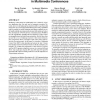Free Online Productivity Tools
i2Speak
i2Symbol
i2OCR
iTex2Img
iWeb2Print
iWeb2Shot
i2Type
iPdf2Split
iPdf2Merge
i2Bopomofo
i2Arabic
i2Style
i2Image
i2PDF
iLatex2Rtf
Sci2ools
NOSSDAV
2015
Springer
2015
Springer
Last N: relevance-based selectivity for forwarding video in multimedia conferences
Multiparty conferencing has traditionally been a relatively expensive application that was only used in enterprise scenarios. Recently, however, the landscape has started to shift in ways that could change this. Ever-increasing bandwidth and processing capabilities make it possible for mobile endpoints and laptop computers to easily handle multiple incoming media streams (both audio and video). The development of Web Real-Time Communications (WebRTC) has also significantly simplified the development of video conferencing applications and made them mainstream. Both of these changes provide a way of replacing expensive video mixers (that produce composited videos) with light-weight video routers (that selectively forward streams). In this paper, we describe a Multipoint Control Unit (MCU) that identifies and selects the last N dominant speakers and forwards their streams to all the conference participants. We evaluate the performance of this Selective Forwarding Unit (SFU) against a ...
| Added | 15 Apr 2016 |
| Updated | 15 Apr 2016 |
| Type | Journal |
| Year | 2015 |
| Where | NOSSDAV |
| Authors | Boris Grozev, Lyubomir Marinov, Varun Singh, Emil Ivov |
Comments (0)

